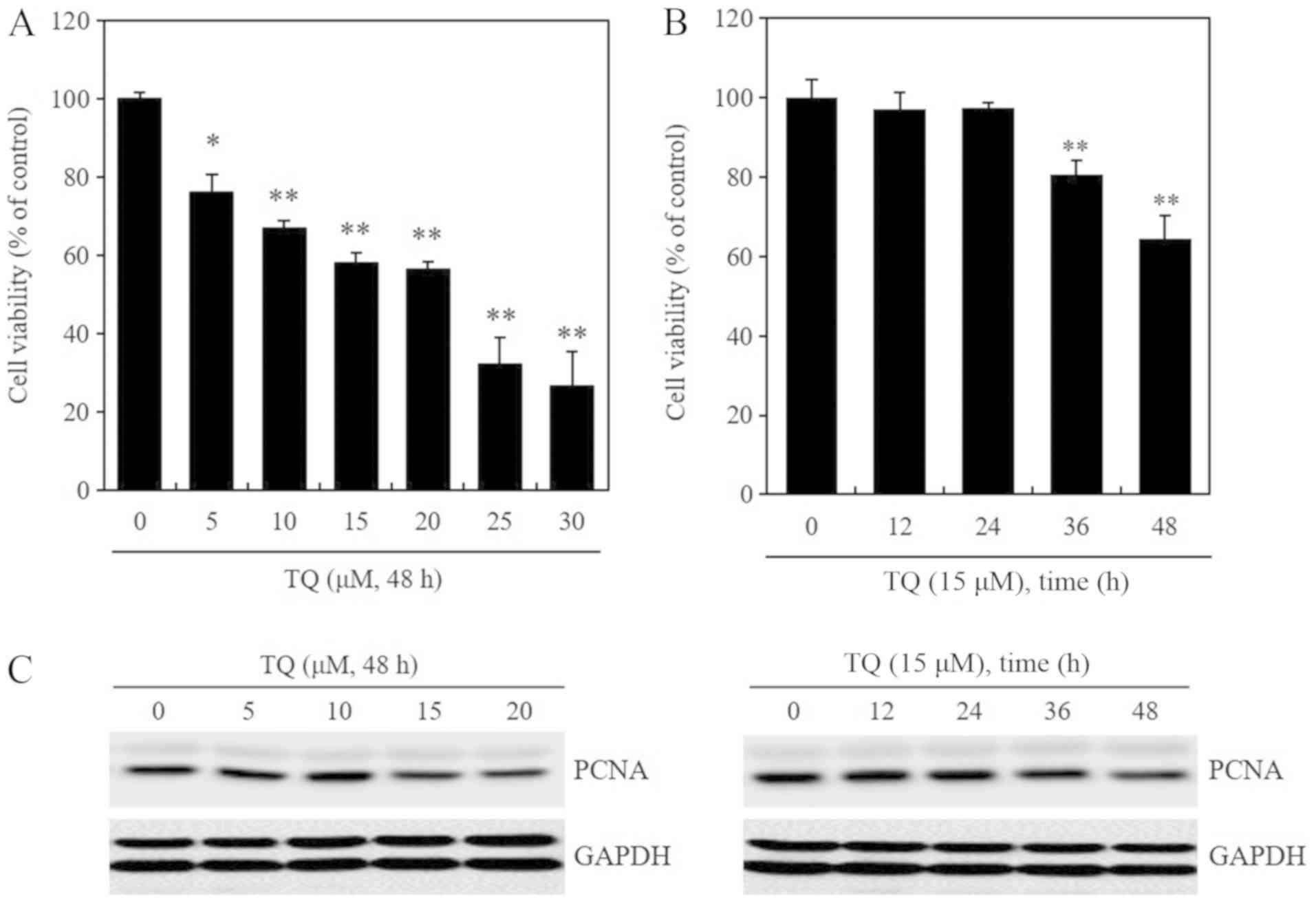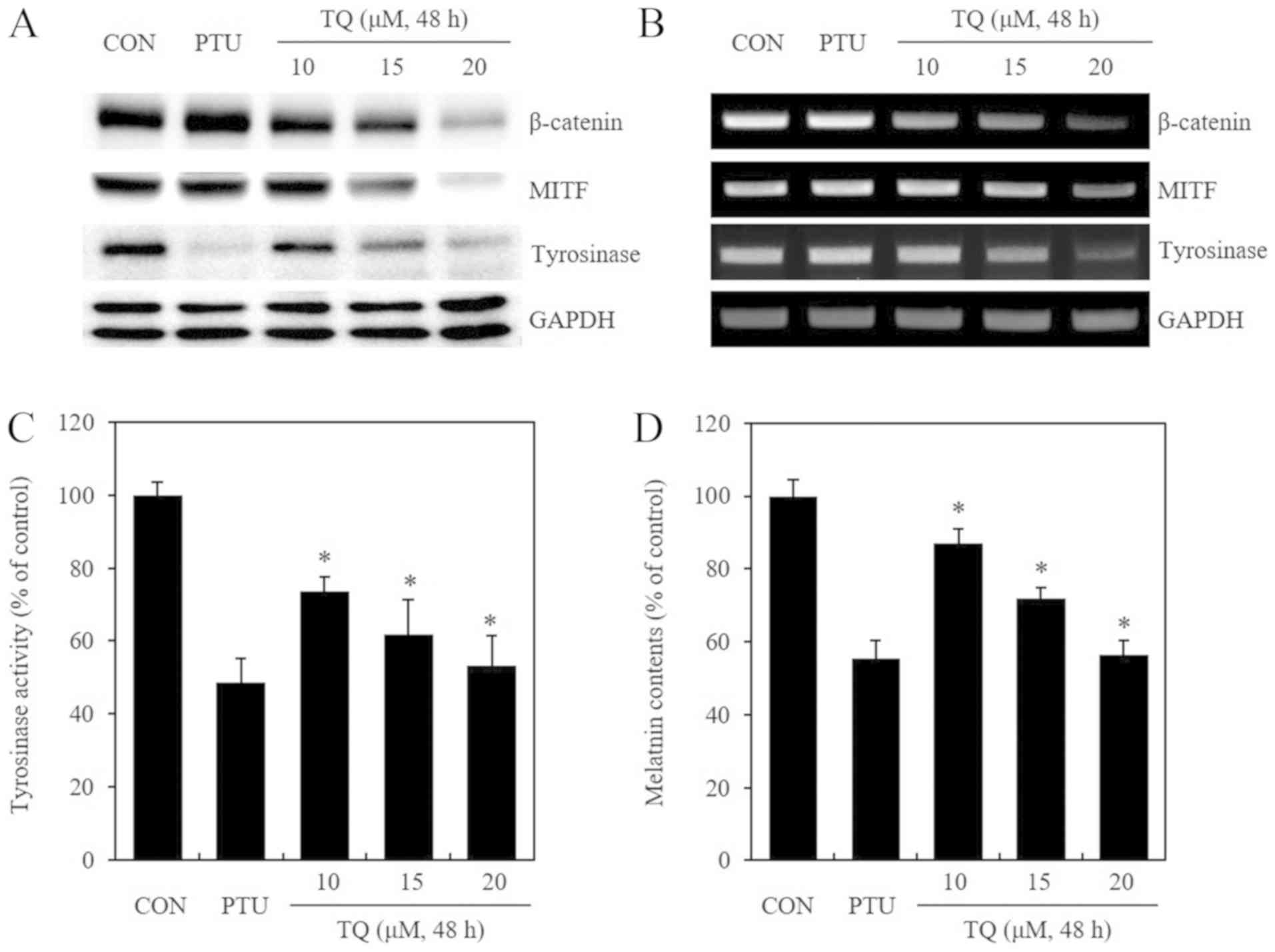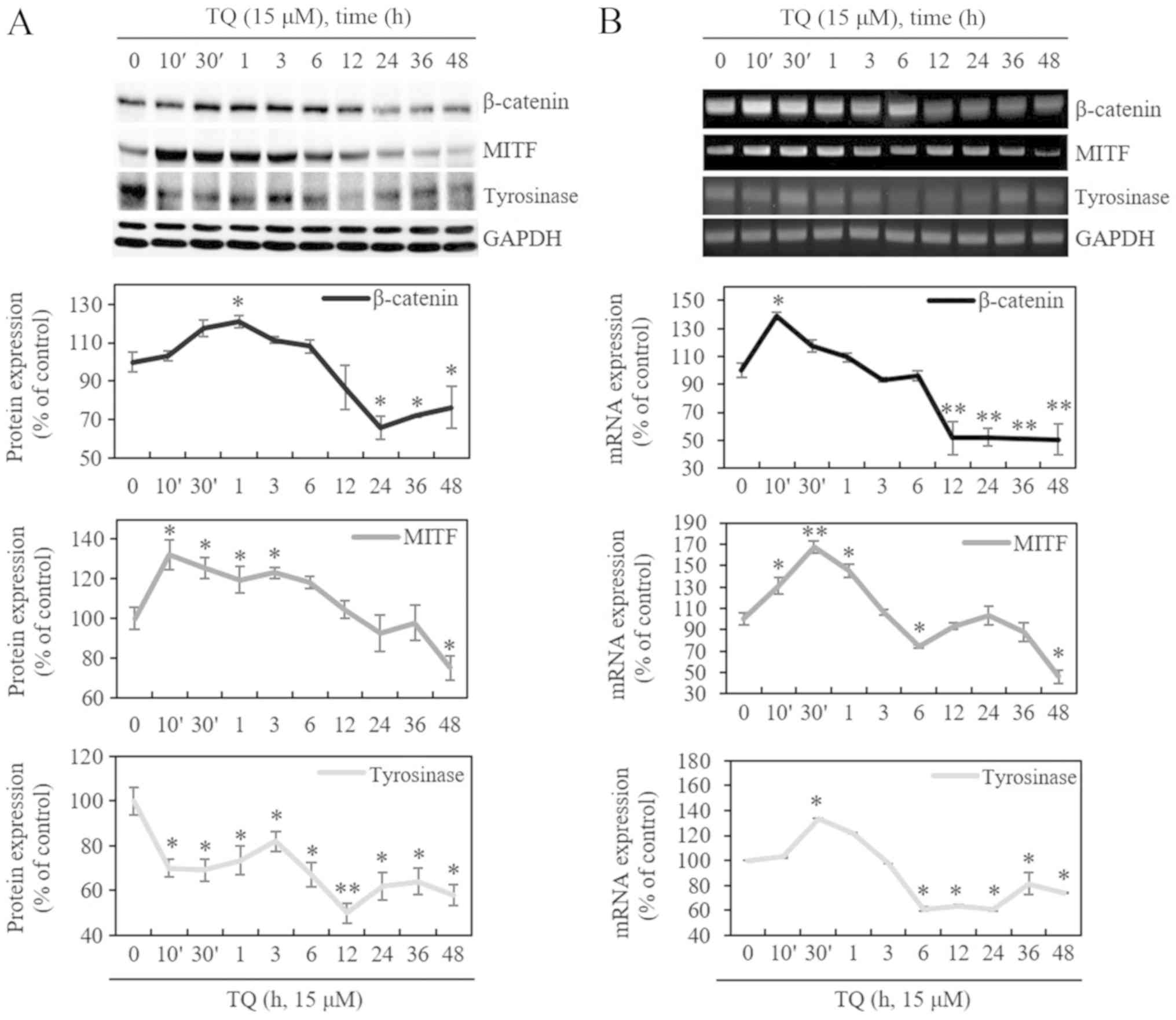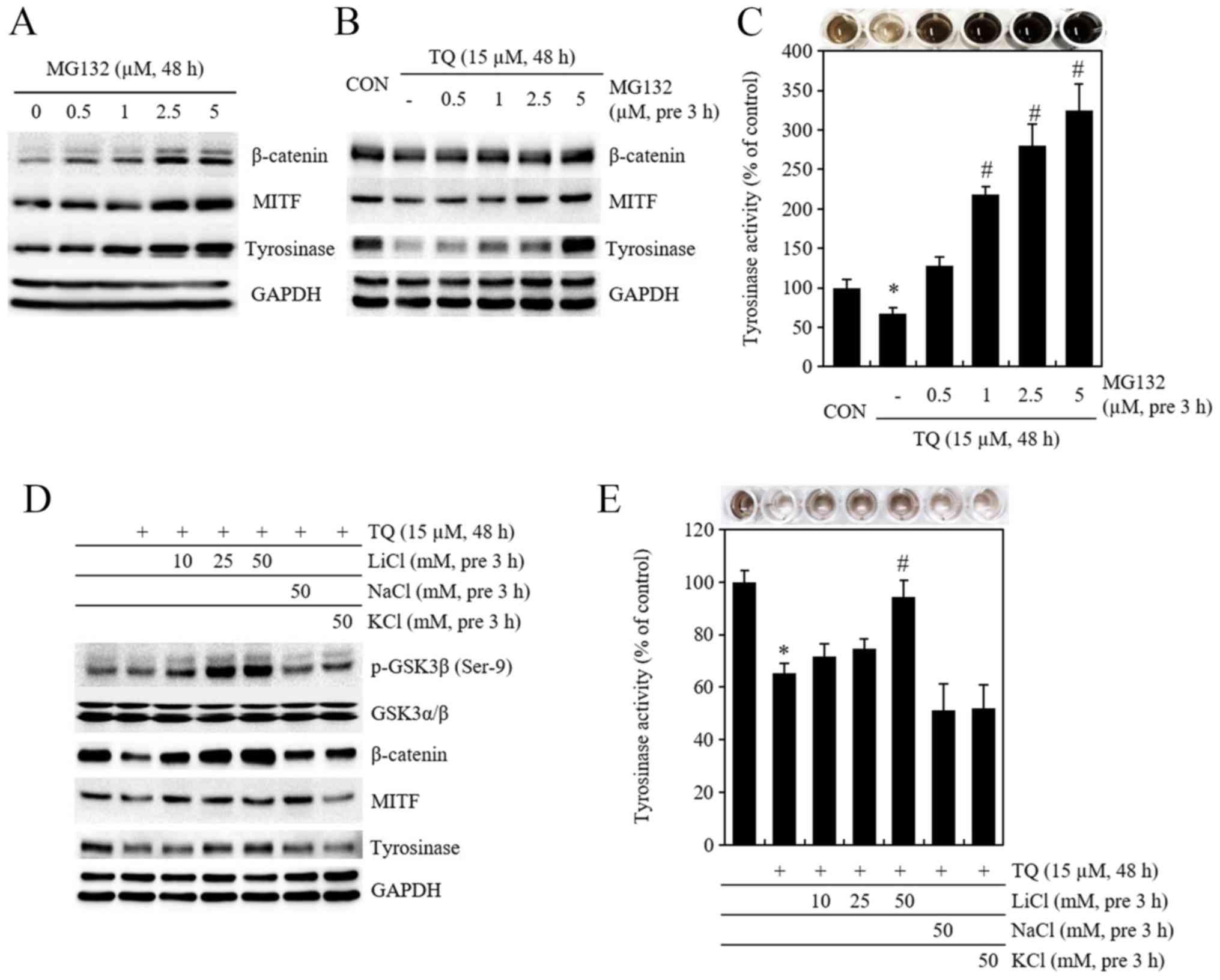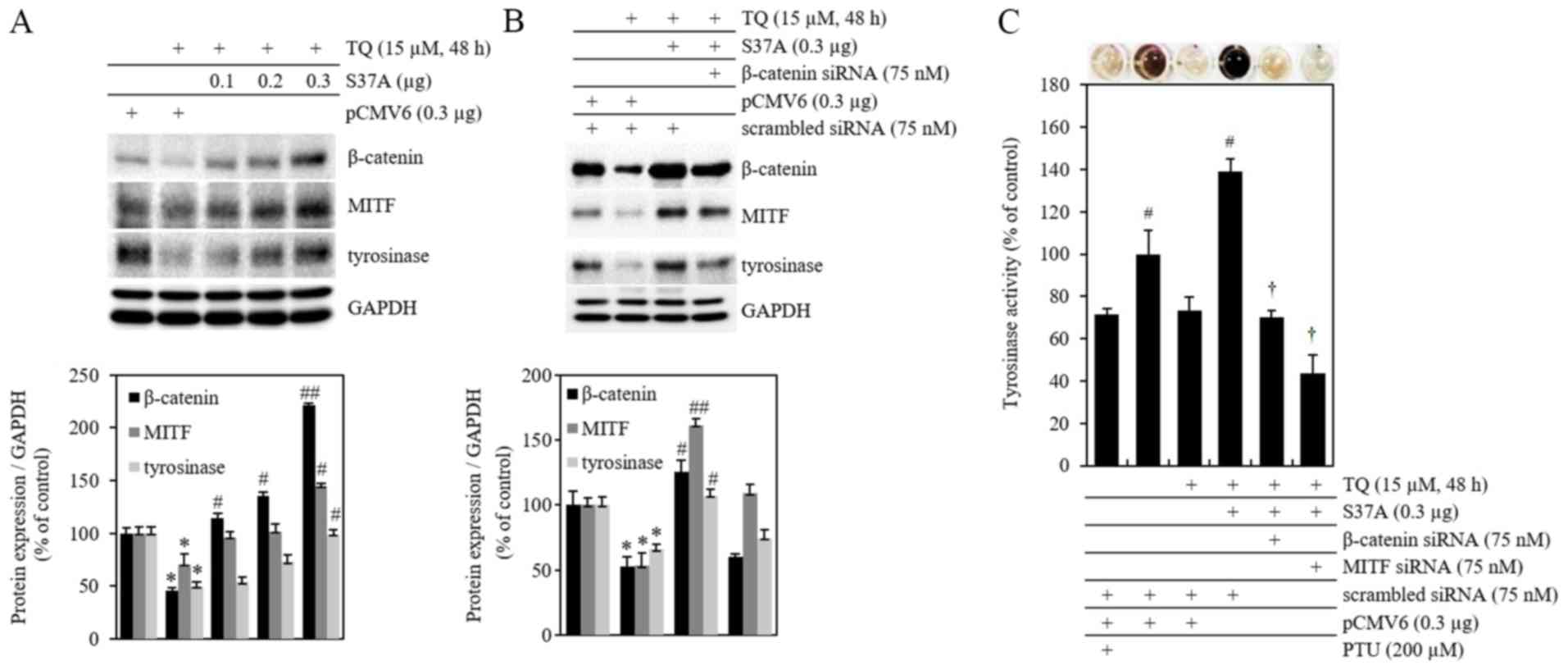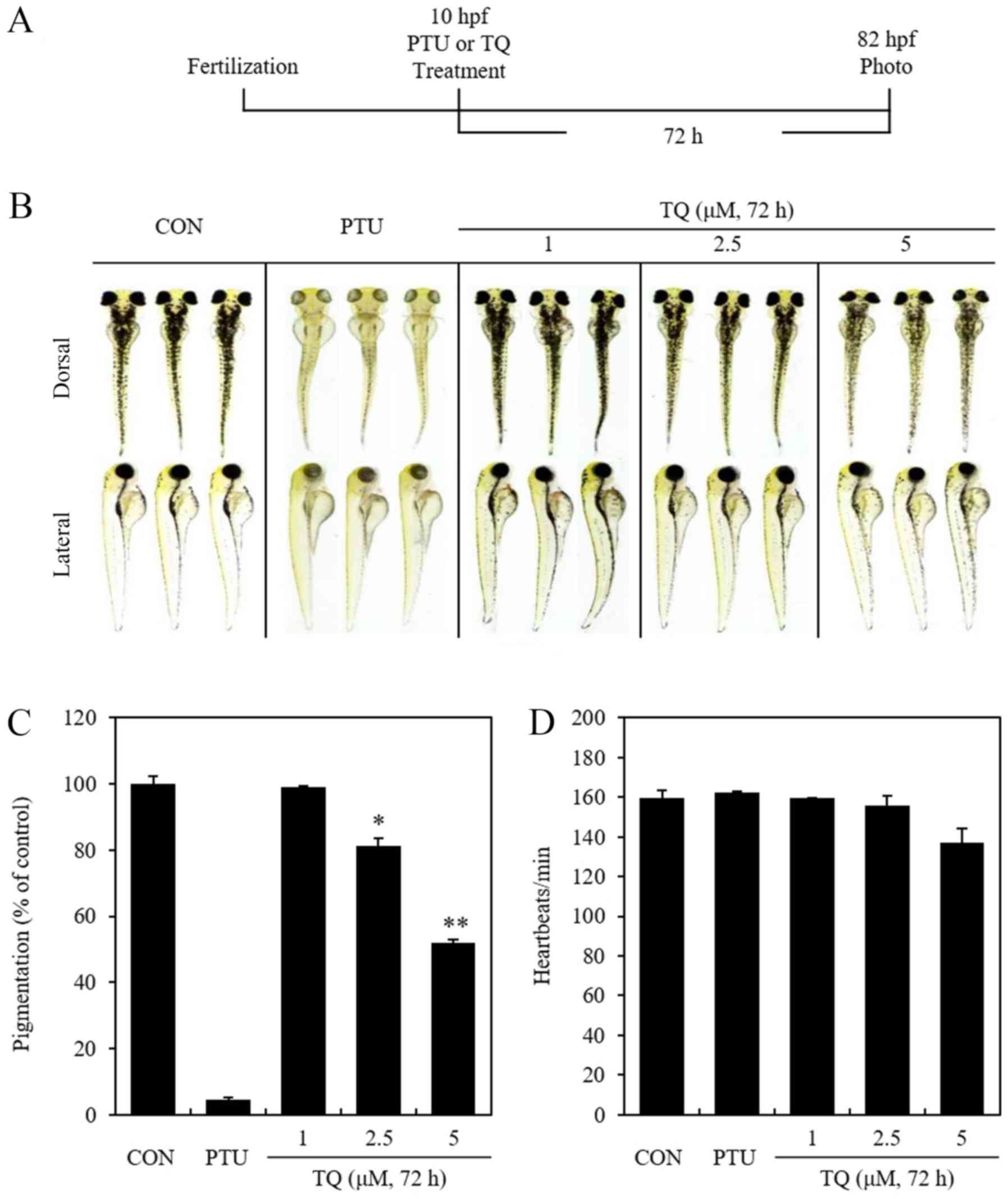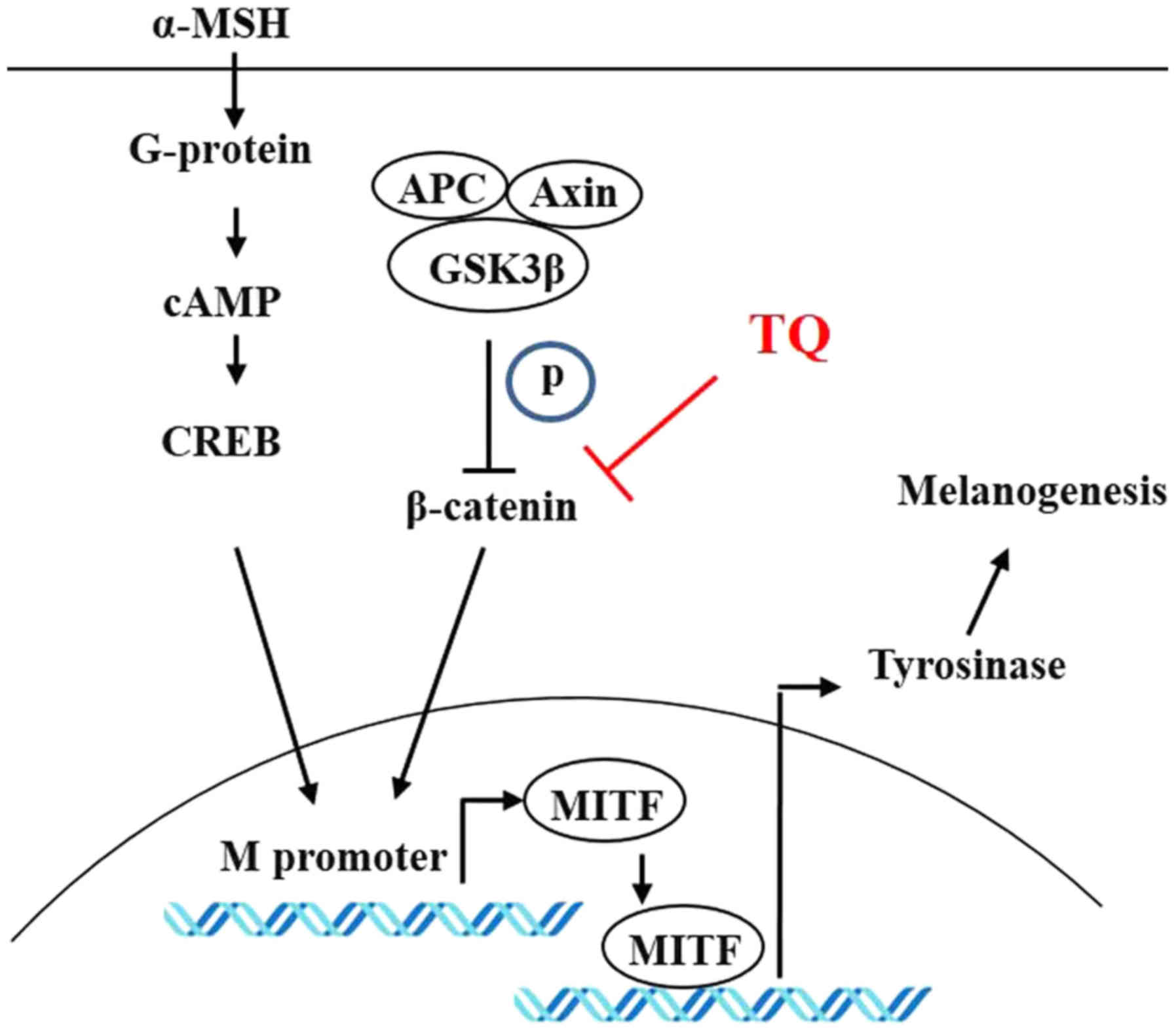|
1
|
Morison WL: What is the function of
melanin? Arch Dermatol. 121:1160–1163. 1985. View Article : Google Scholar : PubMed/NCBI
|
|
2
|
Schallreuter KU, Kothari S, Chavan B and
Spencer JD: Regulation of melanogenesis - controversies and new
concepts. Exp Dermatol. 17:395–404. 2008. View Article : Google Scholar : PubMed/NCBI
|
|
3
|
Lu Y, Zhu WY, Tan C, Yu GH and Gu JX:
Melanocytes are potential immunocompetent cells: Evidence from
recognition of immunological characteristics of cultured human
melanocytes. Pigment Cell Res. 15:454–460. 2002. View Article : Google Scholar : PubMed/NCBI
|
|
4
|
Plonka PM, Passeron T, Brenner M, Tobin
DJ, Shibahara S, Thomas A, Slominski A, Kadekaro AL, Hershkovitz D,
Peters E, et al: What are melanocytes really doing all day long?
Exp Dermatol. 18:799–819. 2009. View Article : Google Scholar : PubMed/NCBI
|
|
5
|
Park HY, Kosmadaki M, Yaar M and Gilchrest
BA: Cellular mechanisms regulating human melanogenesis. Cell Mol
Life Sci. 66:1493–1506. 2009. View Article : Google Scholar : PubMed/NCBI
|
|
6
|
Tachibana M: MITF: A stream flowing for
pigment cells. Pigment Cell Res. 13:230–240. 2000. View Article : Google Scholar : PubMed/NCBI
|
|
7
|
Costin GE and Hearing VJ: Human skin
pigmentation: Melanocytes modulate skin color in response to
stress. FASEB J. 21:976–994. 2007. View Article : Google Scholar : PubMed/NCBI
|
|
8
|
Gilchrest BA, Park HY, Eller MS and Yaar
M: Mechanisms of ultraviolet light-induced pigmentation. Photochem
Photobiol. 63:1–10. 1996. View Article : Google Scholar : PubMed/NCBI
|
|
9
|
Slominski A, Tobin DJ, Shibahara S and
Wortsman J: Melanin pigmentation in mammalian skin and its hormonal
regulation. Physiol Rev. 84:1155–1228. 2004. View Article : Google Scholar : PubMed/NCBI
|
|
10
|
Videira IF, Moura DF and Magina S:
Mechanisms regulating melanogenesis. An Bras Dermatol. 88:76–83.
2013. View Article : Google Scholar : PubMed/NCBI
|
|
11
|
Matoba Y, Kumagai T, Yamamoto A, Yoshitsu
H and Sugiyama M: Crystallographic evidence that the dinuclear
copper center of tyrosinase is flexible during catalysis. J Biol
Chem. 281:8981–8990. 2006. View Article : Google Scholar : PubMed/NCBI
|
|
12
|
Branza-Nichita N, Negroiu G, Petrescu AJ,
Garman EF, Platt FM, Wormald MR, Dwek RA and Petrescu SM: Mutations
at critical N-glycosylation sites reduce tyrosinase activity by
altering folding and quality control. J Biol Chem. 275:8169–8175.
2000. View Article : Google Scholar : PubMed/NCBI
|
|
13
|
Wasmeier C, Hume AN, Bolasco G and Seabra
MC: Melanosomes at a glance. J Cell Sci. 121:3995–3999. 2008.
View Article : Google Scholar : PubMed/NCBI
|
|
14
|
Kanavy HE and Gerstenblith MR: Ultraviolet
radiation and melanoma. Semin Cutan Med Surg. 30:222–228. 2011.
View Article : Google Scholar : PubMed/NCBI
|
|
15
|
Kraus C, Liehr T, Hülsken J, Behrens J,
Birchmeier W, Grzeschik KH and Ballhausen WG: Localization of the
human beta-catenin gene (CTNNB1) to 3p21: A region implicated in
tumor development. Genomics. 23:272–274. 1994. View Article : Google Scholar : PubMed/NCBI
|
|
16
|
Orford K, Crockett C, Jensen JP, Weissman
AM and Byers SW: Serine phosphorylation-regulated ubiquitination
and degradation of beta-catenin. J Biol Chem. 272:24735–24738.
1997. View Article : Google Scholar : PubMed/NCBI
|
|
17
|
Aberle H, Bauer A, Stappert J, Kispert A
and Kemler R: beta-catenin is a target for the ubiquitin-proteasome
pathway. EMBO J. 16:3797–3804. 1997. View Article : Google Scholar : PubMed/NCBI
|
|
18
|
Winston JT, Strack P, Beer-Romero P, Chu
CY, Elledge SJ and Harper JW: The SCFbeta-TRCP-ubiquitin ligase
complex associates specifically with phosphorylated destruction
motifs in IkappaBalpha and beta-catenin and stimulates IkappaBalpha
ubiquitination in vitro. Genes Dev. 13:270–283. 1999. View Article : Google Scholar : PubMed/NCBI
|
|
19
|
Levy C, Khaled M and Fisher DE: MITF:
Master regulator of melanocyte development and melanoma oncogene.
Trends Mol Med. 12:406–414. 2006. View Article : Google Scholar : PubMed/NCBI
|
|
20
|
Bellei B, Pitisci A, Catricalà C, Larue L
and Picardo M: Wnt/β-catenin signaling is stimulated by
α-melanocyte-stimulating hormone in melanoma and melanocyte cells:
Implication in cell differentiation. Pigment Cell Melanoma Res.
24:309–325. 2011. View Article : Google Scholar
|
|
21
|
Yasumoto K, Takeda K, Saito H, Watanabe K,
Takahashi K and Shibahara S: Microphthalmia-associated
transcription factor interacts with LEF-1, a mediator of Wnt
signaling. EMBO J. 21:2703–2714. 2002. View Article : Google Scholar : PubMed/NCBI
|
|
22
|
Mollaaghababa R and Pavan WJ: The
importance of having your SOX on: Role of SOX10 in the development
of neural crest-derived melanocytes and glia. Oncogene.
22:3024–3034. 2003. View Article : Google Scholar : PubMed/NCBI
|
|
23
|
D'Mello SA, Finlay GJ, Baguley BC and
Askarian-Amiri ME: Signaling pathways in melanogenesis. Int J Mol
Sci. 17:E11442016. View Article : Google Scholar : PubMed/NCBI
|
|
24
|
Ando H, Kondoh H, Ichihashi M and Hearing
VJ: Approaches to identify inhibitors of melanin biosynthesis via
the quality control of tyrosinase. J Invest Dermatol. 127:751–761.
2007. View Article : Google Scholar : PubMed/NCBI
|
|
25
|
Maeda K and Fukuda M: Arbutin: Mechanism
of its depigmenting action in human melanocyte culture. J Pharmacol
Exp Ther. 276:765–769. 1996.PubMed/NCBI
|
|
26
|
Battaini G, Monzani E, Casella L,
Santagostini L and Pagliarin R: Inhibition of the catecholase
activity of biomimetic dinuclear copper complexes by kojic acid. J
Biol Inorg Chem. 5:262–268. 2000. View Article : Google Scholar : PubMed/NCBI
|
|
27
|
DuBOIS KP and Erway WF: Studies on the
mechanism of action of thiourea and related compounds; inhibition
of oxidative enzymes and oxidations catalyzed by copper. J Biol
Chem. 165:711–721. 1946.PubMed/NCBI
|
|
28
|
Hall AM and Orlow SJ: Degradation of
tyrosinase induced by phenylthiourea occurs following Golgi
maturation. Pigment Cell Res. 18:122–129. 2005. View Article : Google Scholar : PubMed/NCBI
|
|
29
|
Gali-Muhtasib H, Diab-Assaf M, Boltze C,
Al-Hmaira J, Hartig R, Roessner A and Schneider-Stock R:
Thymoquinone extracted from black seed triggers apoptotic cell
death in human colorectal cancer cells via a p53-dependent
mechanism. Int J Oncol. 25:857–866. 2004.PubMed/NCBI
|
|
30
|
Daba MH and Abdel-Rahman MS:
Hepatoprotective activity of thymoquinone in isolated rat
hepatocytes. Toxicol Lett. 95:23–29. 1998. View Article : Google Scholar : PubMed/NCBI
|
|
31
|
Asaduzzaman Khan M, Tania M, Fu S and Fu
J: Thymoquinone, as an anticancer molecule: From basic research to
clinical investigation. Oncotarget. 8:51907–51919. 2017.PubMed/NCBI
|
|
32
|
Hossen MJ, Yang WS, Kim D, Aravinthan A,
Kim JH and Cho JY: Thymoquinone: An IRAK1 inhibitor with in vivo
and in vitro anti-inflammatory activities. Sci Rep. 7:429952017.
View Article : Google Scholar : PubMed/NCBI
|
|
33
|
Mostofa AGM, Hossain MK, Basak D and Bin
Sayeed MS: Thymoquinone as a potential adjuvant therapy for cancer
treatment: Evidence from preclinical studies. Front Pharmacol.
8:2952017. View Article : Google Scholar : PubMed/NCBI
|
|
34
|
Matthews M and Varga ZM: Anesthesia and
euthanasia in zebrafish. ILAR J. 53:192–204. 2012. View Article : Google Scholar
|
|
35
|
Strykowski JL and Schech JM: Effectiveness
of recommended euthanasia methods in larval zebrafish (Danio
rerio). J Am Assoc Lab Anim Sci. 54:81–84. 2015.PubMed/NCBI
|
|
36
|
Wilk R, Ali N, England SJ and Lewis KE:
Using zebrafish to bring hands-on laboratory experiences to urban
classrooms. Zebrafish. 15:156–178. 2018. View Article : Google Scholar : PubMed/NCBI
|
|
37
|
Wang Y, Liu S, Dong W, Qu X, Huang C, Yan
T and Du J: Combination of hesperetin and platinum enhances
anticancer effect on lung adenocarcinoma. Biomed Pharmacother.
113:1087792019. View Article : Google Scholar : PubMed/NCBI
|
|
38
|
Yang Y, Wang C, Zhao K, Zhang G, Wang D
and Mei Y: TRMP, a p53-inducible long noncoding RNA, regulates G1/S
cell cycle progression by modulating IRES-dependent p27
translation. Cell Death Dis. 9:8862018. View Article : Google Scholar : PubMed/NCBI
|
|
39
|
Ouchida AT, Li Y, Geng J, Najafov A,
Ofengeim D, Sun X, Yu Q and Yuan J: Synergistic effect of a novel
autophagy inhibitor and quizartinib enhances cancer cell death.
Cell Death Dis. 9:1382018. View Article : Google Scholar : PubMed/NCBI
|
|
40
|
Stones DH, Fehr AGJ, Thompson L, et al:
Zebrafish (Danio rerio) as a vertebrate model host to study
colonization, pathogenesis, and transmission of foodborne
Escherichia coli O157. mSphere. 2:e003652017. View Article : Google Scholar :
|
|
41
|
Gray-Schopfer V, Wellbrock C and Marais R:
Melanoma biology and new targeted therapy. Nature. 445:851–857.
2007. View Article : Google Scholar : PubMed/NCBI
|
|
42
|
Woo CC, Kumar AP, Sethi G and Tan KH:
Thymoquinone: Potential cure for inflammatory disorders and cancer.
Biochem Pharmacol. 83:443–451. 2012. View Article : Google Scholar
|
|
43
|
Woo CC, Hsu A, Kumar AP, Sethi G and Tan
KH: Thymoquinone inhibits tumor growth and induces apoptosis in a
breast cancer xenograft mouse model: The role of p38 MAPK and ROS.
PLoS One. 8:e753562013. View Article : Google Scholar : PubMed/NCBI
|
|
44
|
Yang J, Kuang XR, Lv PT and Yan XX:
Thymoquinone inhibits proliferation and invasion of human
nonsmall-cell lung cancer cells via ERK pathway. Tumour Biol.
36:259–269. 2015. View Article : Google Scholar
|
|
45
|
Hatiboglu MA, Kocyigit A, Guler EM, Akdur
K, Nalli A, Karatas E and Tuzgen S: Thymoquinone induces apoptosis
in B16-F10 melanoma cell through inhibition of p-STAT3 and inhibits
tumor growth in a murine intracerebral melanoma model. World
Neurosurg. 114:e182–e190. 2018. View Article : Google Scholar : PubMed/NCBI
|
|
46
|
Yu SM and Kim SJ: Thymoquinone-induced
reactive oxygen species causes apoptosis of chondrocytes via
PI3K/Akt and p38kinase pathway. Exp Biol Med (Maywood).
238:811–820. 2013. View Article : Google Scholar
|
|
47
|
Jope RS, Yuskaitis CJ and Beurel E:
Glycogen synthase kinase-3 (GSK3): Inflammation, diseases, and
therapeutics. Neurochem Res. 32:577–595. 2007. View Article : Google Scholar :
|
|
48
|
De Sarno P, Li X and Jope RS: Regulation
of Akt and glycogen synthase kinase-3 beta phosphorylation by
sodium valproate and lithium. Neuropharmacology. 43:1158–1164.
2002. View Article : Google Scholar : PubMed/NCBI
|
|
49
|
Haegel H, Larue L, Ohsugi M, Fedorov L,
Herrenknecht K and Kemler R: Lack of beta-catenin affects mouse
development at gastrulation. Development. 121:3529–3537.
1995.PubMed/NCBI
|
|
50
|
Kelly GM, Erezyilmaz DF and Moon RT:
Induction of a secondary embryonic axis in zebrafish occurs
following the overexpression of beta-catenin. Mech Dev. 53:261–273.
1995. View Article : Google Scholar : PubMed/NCBI
|



